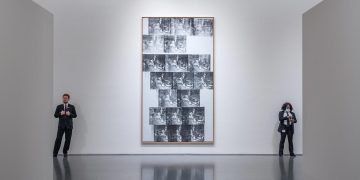In the world of art, some exhibitions leave a profound impact that stretches far beyond the art itself. A few rare shows, often due to their controversial nature, spark discourse that reverberates for years, with the materials associated with them becoming highly sought after collectibles. One such case involves an exhibition catalog that was banned, yet has become an unlikely and incredibly lucrative commodity in the secondary market. The catalog in question, once pulled from circulation due to its provocative content, is now commanding astronomical prices, with some copies selling for as much as $10,000. In this article, we will profile the story behind this controversial exhibition catalog, explain how it became so valuable, and explore the factors that drive the secondary market for such banned materials.
The Controversial Exhibition That Sparked Outrage
To understand why a banned exhibition catalog could fetch such a high price, we must first take a closer look at the exhibition it documents. While the catalog’s existence was initially met with enthusiasm, the exhibition itself quickly became the subject of heated debates. The exhibition in question was intended to explore sensitive social, political, or cultural themes, pushing the boundaries of accepted norms in the art world. Its inclusion of provocative or politically charged works ignited widespread controversy, with some viewing it as groundbreaking and others as outright offensive.
The museum or gallery that hosted the exhibition likely underestimated the public outcry that would follow. Within weeks of the show’s opening, protests ensued, and influential figures within the art world denounced the exhibition for its perceived lack of taste or failure to adhere to traditional artistic boundaries. The exhibition’s controversial nature caused it to be shut down early, with curators and museum directors facing mounting pressure from stakeholders, including donors, sponsors, and even political figures.
Despite the exhibition’s premature closure, one particular artifact from this event—the catalog itself—remained an object of fascination. The catalog, containing images, essays, and statements from the artists, encapsulated the essence of the exhibition and its bold, unfiltered message. For many, owning a piece of this exhibition’s history became a symbol of defiance, rebellion, and artistic freedom.
The Decision to Ban the Catalog: A Strategic Move or an Oversight?
The decision to ban the exhibition catalog was one of the most pivotal moments in this story. Following the backlash and the exhibition’s closure, the museum decided to remove the catalog from circulation. Whether the ban was a strategic move to distance the institution from the controversy or an attempt to control the narrative remains unclear. What is certain is that this ban only added fuel to the flames of curiosity surrounding the catalog.
Banning art materials, especially catalogs, often has the opposite of the intended effect. Rather than suppressing interest, it amplifies it, creating an aura of mystery and rarity that makes the banned item more desirable. In the case of this exhibition catalog, its status as an elusive artifact transformed it into an object of fascination for collectors, scholars, and art enthusiasts.

The Power of Rarity in the Art Market
In the art world, rarity is one of the key drivers of value. While some art collectors pursue established masterpieces or iconic works, others seek out objects that have a unique story to tell—particularly items with a controversial or forbidden history. The banned exhibition catalog’s scarcity played a major role in its rise in value. Once it was pulled from circulation, only a limited number of copies were in circulation, and those who owned them held onto them as rare pieces of art history.
As time passed, the catalog’s value increased dramatically. Collectors looking for a piece of art history with an edge started bidding for copies at ever-higher prices. Auction houses began listing the catalog, often with the phrase “extremely rare” in the description, further elevating its appeal. The catalog, once seen as a mere exhibition guide, had transformed into a coveted collector’s item, with prices soaring to unprecedented levels.
The concept of rarity is particularly potent in the secondary market, where collectors are often willing to pay a premium for items that are no longer readily available. In the case of this banned exhibition catalog, its status as an object banned from public view made it even more desirable. As more collectors became aware of its existence, demand continued to climb, leading to the market values we see today.
The Secondary Market: A World of High Stakes and High Risk
The secondary market for banned exhibition catalogs is complex and competitive. Prices can vary significantly depending on the condition of the catalog, its provenance, and its historical importance. Copies of the catalog that were sold immediately after the exhibition’s closure, or those that were acquired directly from museum staff or artists involved in the exhibition, are often the most valuable.
For collectors, buying a banned exhibition catalog is not just a financial investment; it’s a gamble. The secondary market is filled with both legitimate items and counterfeit copies, making the process of buying and selling these catalogs highly specialized. Collectors and dealers rely on authenticity experts, provenance documentation, and auction records to ensure that they are acquiring genuine copies of these rare materials. As the market for banned exhibition catalogs continues to grow, the demand for authentication services has also increased, further fueling the high-stakes environment.
Auction houses, such as Sotheby’s and Christie’s, have played a pivotal role in the catalog’s secondary market, facilitating sales that can fetch tens of thousands of dollars. Some of these auctions feature not just the catalog but also accompanying works of art or memorabilia from the exhibition, further driving up the price. For example, a catalog from a groundbreaking political art exhibition might be sold alongside pieces that directly relate to the controversial themes the exhibition addressed, adding layers of meaning and value to the transaction.
The Psychology Behind Collecting Banned Materials
What makes the appeal of banned exhibition catalogs so powerful? To answer this question, we must consider the psychology behind collecting. For many collectors, acquiring banned or suppressed materials is a way of engaging with forbidden knowledge and exploring the boundaries of artistic expression. The banned catalog represents more than just a historical record; it symbolizes resistance, transgression, and the courage to challenge societal norms.
Collectors are often motivated by the desire to own a piece of history, particularly when that history is controversial or marginal. Banned catalogs, in this sense, function as time capsules that preserve the spirit of artistic rebellion and intellectual defiance. By owning such a catalog, collectors feel as though they are in possession of something rare and transformative—something that challenges the status quo.
The secondary market for banned exhibition catalogs also plays into the desire for exclusivity. In a world where most museum catalogs are mass-produced and easily accessible, owning a rare and forbidden catalog is a badge of honor, a way to distinguish oneself as part of an elite group of collectors who value art not just for its aesthetic qualities but for its cultural and political significance.
How Banned Exhibition Catalogs Impact the Art Market
The growing demand for banned exhibition catalogs has had a broader impact on the art market as a whole. Collectors’ interest in controversial or suppressed works has led to a wider recognition of the value of materials that were once considered ephemera—such as exhibition catalogs, posters, and promotional materials. These items, which were historically seen as disposable or secondary to the artwork itself, are now recognized as vital components of art history.
As a result, the market for exhibition materials has become more robust, with dealers specializing in rare and controversial items. Auction houses are increasingly offering catalogs, posters, and related materials as part of their fine art auctions, recognizing that these items can fetch significant sums. The sale of banned exhibition catalogs also opens up new avenues for art institutions and collectors to monetize their holdings, further blurring the lines between fine art and collectible materials.
This shift in the art market is a reflection of the growing trend toward the commodification of culture. Just as contemporary artists have turned to new forms of art like NFTs and limited-edition prints, the secondary market for exhibition materials reflects an evolving understanding of what constitutes valuable art. As the lines between art, memorabilia, and ephemera continue to blur, the market for banned materials will only continue to expand, with collectors willing to pay ever-higher prices for a piece of history that no one thought they could own.
The Legacy of the Banned Catalog
The legacy of the banned exhibition catalog is a testament to the power of controversy in the art world. What was once rejected and suppressed has become a symbol of artistic freedom, resistance, and historical importance. The high price that these catalogs now command is a reflection of both their rarity and their cultural significance. In the end, the catalog represents more than just a record of an exhibition; it encapsulates the tension between censorship and creativity, the clash between artistic vision and societal norms, and the enduring power of art to provoke, challenge, and inspire.

















































